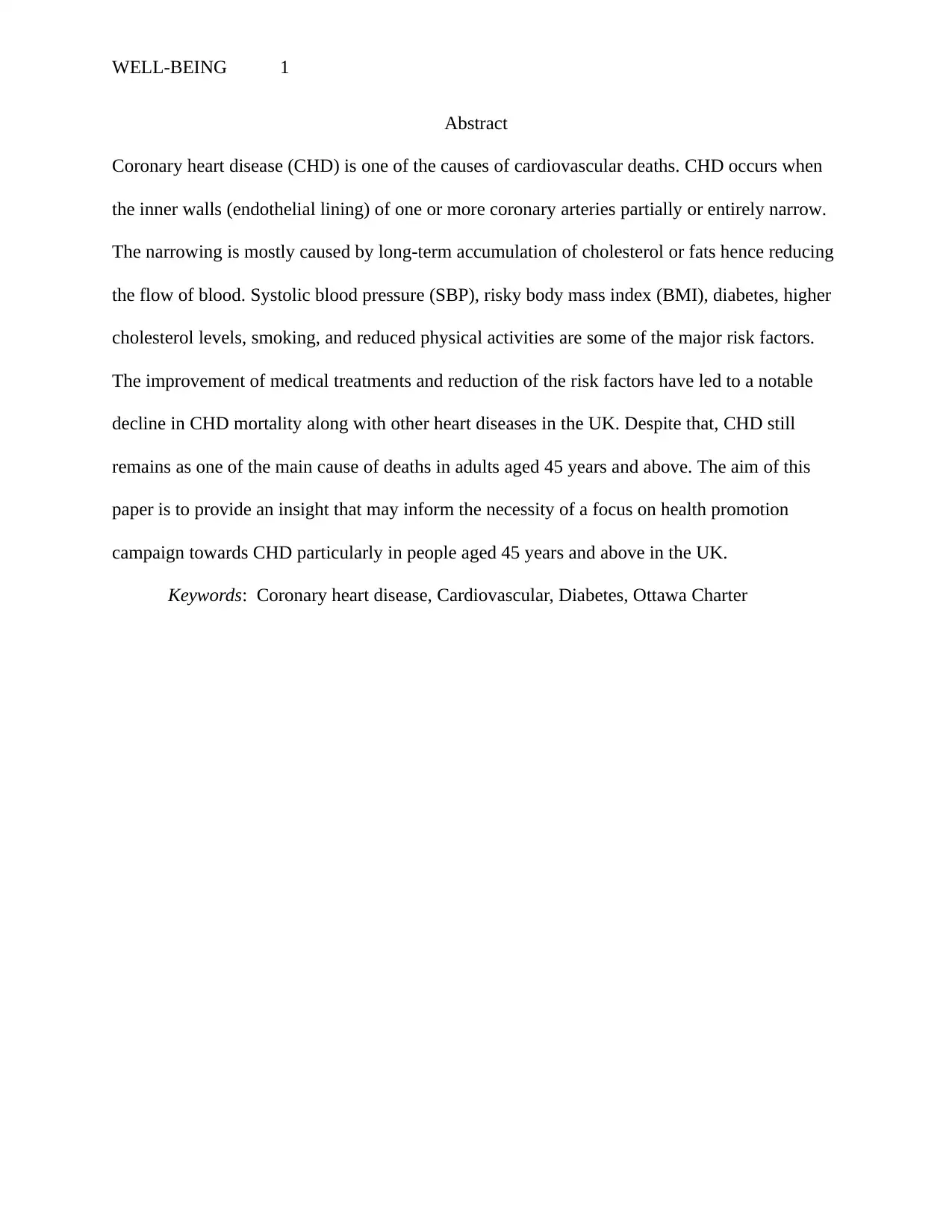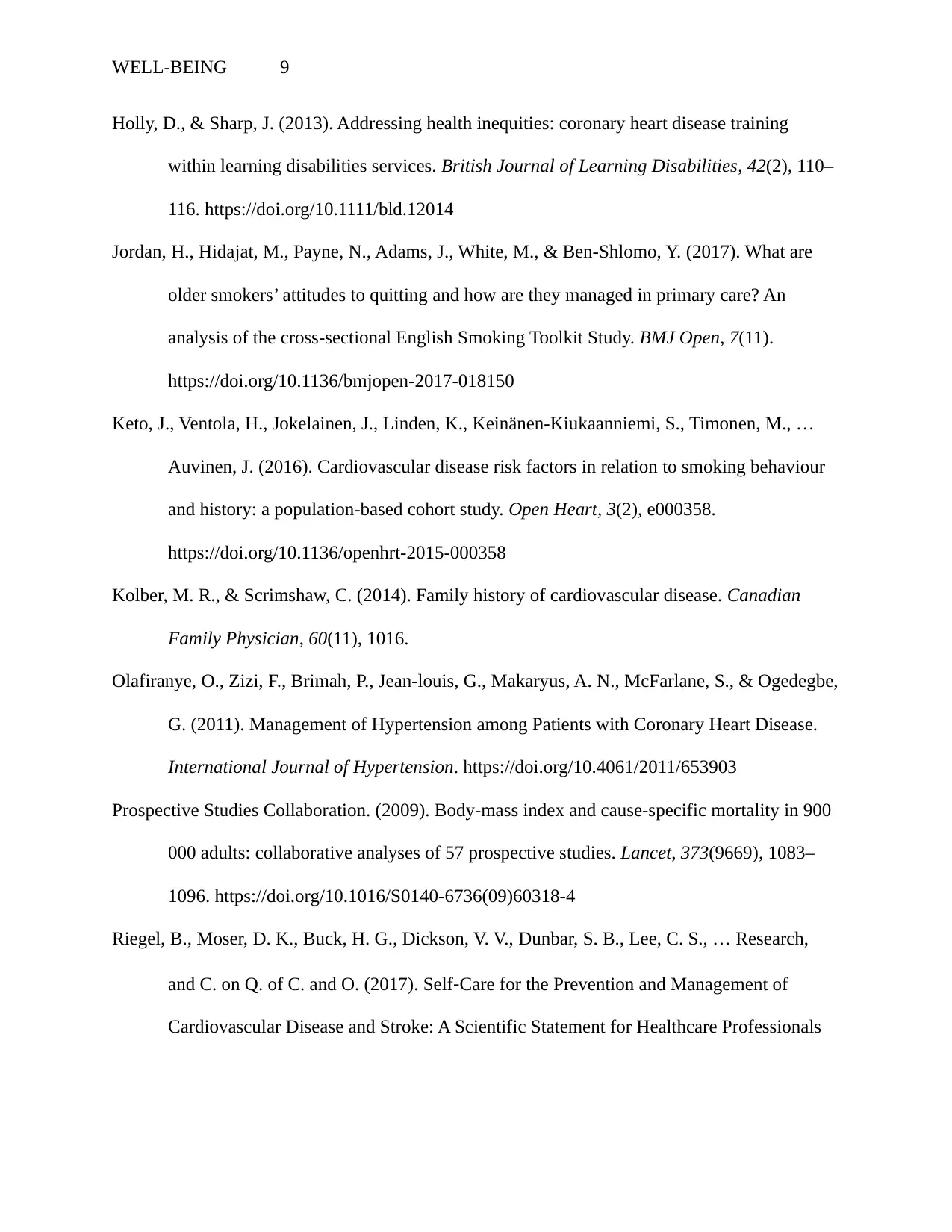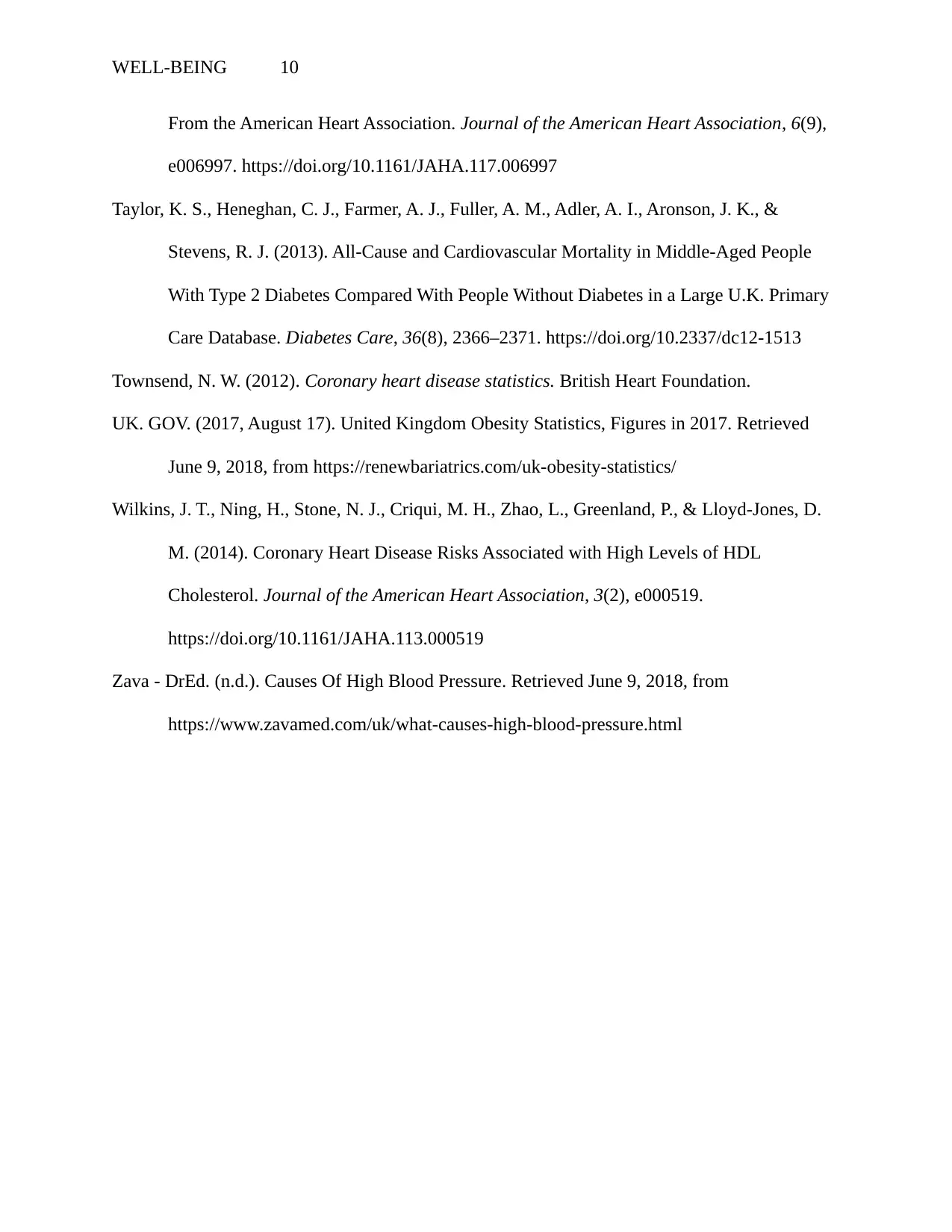Health Promotion Imperative: CHD in UK Adults Aged 45 and Above
VerifiedAdded on 2023/06/11
|11
|3006
|111
Essay
AI Summary
This essay argues for prioritizing health promotion campaigns targeting coronary heart disease (CHD) in the UK, specifically focusing on individuals aged 45 and above. It highlights CHD's prevalence and mortality rates, despite declining trends, and emphasizes the significance of addressing risk factors like smoking, high blood pressure, cholesterol, diabetes, and physical inactivity. The paper justifies focusing on the 45+ age group due to their increased susceptibility to these risk factors and the potential for greater impact through targeted interventions. It also suggests implementing health promotion actions based on the Ottawa Charter's framework, including developing healthy public policies, creating supportive environments, strengthening community actions, developing personal skills, and re-orienting healthcare services towards prevention. The essay concludes that focusing on this demographic and implementing comprehensive strategies can significantly reduce CHD's burden in the UK.

Running head: WELL-BEING
National Health Priority in Coronary Heart Disease
Author Name(s)
Institutional Affiliation(s)
Author Note
National Health Priority in Coronary Heart Disease
Author Name(s)
Institutional Affiliation(s)
Author Note
Paraphrase This Document
Need a fresh take? Get an instant paraphrase of this document with our AI Paraphraser

WELL-BEING 1
Abstract
Coronary heart disease (CHD) is one of the causes of cardiovascular deaths. CHD occurs when
the inner walls (endothelial lining) of one or more coronary arteries partially or entirely narrow.
The narrowing is mostly caused by long-term accumulation of cholesterol or fats hence reducing
the flow of blood. Systolic blood pressure (SBP), risky body mass index (BMI), diabetes, higher
cholesterol levels, smoking, and reduced physical activities are some of the major risk factors.
The improvement of medical treatments and reduction of the risk factors have led to a notable
decline in CHD mortality along with other heart diseases in the UK. Despite that, CHD still
remains as one of the main cause of deaths in adults aged 45 years and above. The aim of this
paper is to provide an insight that may inform the necessity of a focus on health promotion
campaign towards CHD particularly in people aged 45 years and above in the UK.
Keywords: Coronary heart disease, Cardiovascular, Diabetes, Ottawa Charter
Abstract
Coronary heart disease (CHD) is one of the causes of cardiovascular deaths. CHD occurs when
the inner walls (endothelial lining) of one or more coronary arteries partially or entirely narrow.
The narrowing is mostly caused by long-term accumulation of cholesterol or fats hence reducing
the flow of blood. Systolic blood pressure (SBP), risky body mass index (BMI), diabetes, higher
cholesterol levels, smoking, and reduced physical activities are some of the major risk factors.
The improvement of medical treatments and reduction of the risk factors have led to a notable
decline in CHD mortality along with other heart diseases in the UK. Despite that, CHD still
remains as one of the main cause of deaths in adults aged 45 years and above. The aim of this
paper is to provide an insight that may inform the necessity of a focus on health promotion
campaign towards CHD particularly in people aged 45 years and above in the UK.
Keywords: Coronary heart disease, Cardiovascular, Diabetes, Ottawa Charter

WELL-BEING 2
Coronary Heart Disease
CHD was previously called the ischaemic heart disease. It is a heart condition where
coronary arteries get narrow due to fatty deposits within the walls. The role of the coronary
arteries is to transport the required body nutrients and oxygenated blood to the heart muscles. A
long-term accumulation of fatty deposits (atheroma) within these arteries makes them narrow
which undermines the transport of oxygen and nutrients to the heart hence causing higher risks
of cardiac events like angina pectoris or a myocardial infarction. Among other prevalent heart
diseases, CHD has the highest mortality rates in the UK and other countries. This paper aims to
demonstrate why the UK should prioritize its health promotion on the management of CHD in
people aged 45 years and above.
The Need for Priority on CHD
According to (Bhatnagar, Wickramasinghe, Williams, Rayner, & Townsend, 2015), CHD
is the leading cause of deaths in UK. Besides, CHD is still the leading global cause of death. In
the UK, the (British Heart Foundation, 2017) reports that about one in every seven men and one
in every twelve women die due to CHD. The study further states that CHD causes 66,000 deaths
in the UK every year. There are a few studies demonstrating that the prevalence of CHD is
decreasing in UK (Bhatnagar et al., 2015; Bhatnagar, Wickramasinghe, Wilkins, & Townsend,
2016). Despite that, the recent study of (Cruise, Hughes, Bennett, Kouvonen, & Kee, 2017)
states that CHD is forecasted to increase by 50% among adults living in the Republic of Ireland
by 2020. Additionally, the death rates have been found to be highest in places such as North of
England and Scotland, and lowest in the Southern areas of England.
The morbidity rates of CHD are still predominant in the UK. For instance, the 2010 study
by (Townsend, 2012) revealed that cases of myocardial infarction were evident occurring in 154
Coronary Heart Disease
CHD was previously called the ischaemic heart disease. It is a heart condition where
coronary arteries get narrow due to fatty deposits within the walls. The role of the coronary
arteries is to transport the required body nutrients and oxygenated blood to the heart muscles. A
long-term accumulation of fatty deposits (atheroma) within these arteries makes them narrow
which undermines the transport of oxygen and nutrients to the heart hence causing higher risks
of cardiac events like angina pectoris or a myocardial infarction. Among other prevalent heart
diseases, CHD has the highest mortality rates in the UK and other countries. This paper aims to
demonstrate why the UK should prioritize its health promotion on the management of CHD in
people aged 45 years and above.
The Need for Priority on CHD
According to (Bhatnagar, Wickramasinghe, Williams, Rayner, & Townsend, 2015), CHD
is the leading cause of deaths in UK. Besides, CHD is still the leading global cause of death. In
the UK, the (British Heart Foundation, 2017) reports that about one in every seven men and one
in every twelve women die due to CHD. The study further states that CHD causes 66,000 deaths
in the UK every year. There are a few studies demonstrating that the prevalence of CHD is
decreasing in UK (Bhatnagar et al., 2015; Bhatnagar, Wickramasinghe, Wilkins, & Townsend,
2016). Despite that, the recent study of (Cruise, Hughes, Bennett, Kouvonen, & Kee, 2017)
states that CHD is forecasted to increase by 50% among adults living in the Republic of Ireland
by 2020. Additionally, the death rates have been found to be highest in places such as North of
England and Scotland, and lowest in the Southern areas of England.
The morbidity rates of CHD are still predominant in the UK. For instance, the 2010 study
by (Townsend, 2012) revealed that cases of myocardial infarction were evident occurring in 154
⊘ This is a preview!⊘
Do you want full access?
Subscribe today to unlock all pages.

Trusted by 1+ million students worldwide

WELL-BEING 3
men and 34 women for every 100,000 men and women. In Scotland, 255 men and 113 women
had myocardial infarction out of every 100,000 men or women (Townsend, 2012). The
incidences of angina were occurring at 38 men and 21 women out of every 100,000 men or
women (Townsend, 2012). Although prevalence rates of CHD are falling, the effects and the
increasing number of survivors of CHD requires emphasis to counter the adverse impacts of
CHD (Townsend, 2012).
The risk factors for CHD
Smoking is counted as a major risk factor to CHD. According to (British Heart
Foundation, 2017), there is more than one person in every six adults who smoke cigarettes in the
UK, and this number adds up to more than 8 million adults in total. This study also states that
there are up to 20,000 deaths resulting from cardiovascular disease in the UK every year, and all
of them are related to smoking. Another risk factor is the High blood pressure (HBP). According
to (Olafiranye et al., 2011), hypertension heightens the development of atherosclerosis, and the
occurrence of HBP destabilizes the vascular lesions which lead to critical coronary events. High
levels of cholesterol in the blood are also said to be another risk factor. This risk was explained in
(Wilkins et al., 2014) that the higher the level of cholesterol in the blood causes an increase in
the risk of CHD as higher levels of cholesterol causes the narrowing of the arteries while a piece
of fat within the blood passage can cause blood clot hence leading to a heart attack.
Another risk factor for CHD is diabetes. According to (Ali, Narayan, & Tandon, 2010),
the type 2 diabetes mellitus is closely associated with CHD. Diabetes is shown to have two to
fourfold higher risk of causing CHD. The work of (Aronson & Edelman, 2014) explains this
concept further by stating that cardiovascular mortality across age groups and sexes increase at
the same rate with the increase of diabetes mellitus. Less physical activities (PA) also increase
men and 34 women for every 100,000 men and women. In Scotland, 255 men and 113 women
had myocardial infarction out of every 100,000 men or women (Townsend, 2012). The
incidences of angina were occurring at 38 men and 21 women out of every 100,000 men or
women (Townsend, 2012). Although prevalence rates of CHD are falling, the effects and the
increasing number of survivors of CHD requires emphasis to counter the adverse impacts of
CHD (Townsend, 2012).
The risk factors for CHD
Smoking is counted as a major risk factor to CHD. According to (British Heart
Foundation, 2017), there is more than one person in every six adults who smoke cigarettes in the
UK, and this number adds up to more than 8 million adults in total. This study also states that
there are up to 20,000 deaths resulting from cardiovascular disease in the UK every year, and all
of them are related to smoking. Another risk factor is the High blood pressure (HBP). According
to (Olafiranye et al., 2011), hypertension heightens the development of atherosclerosis, and the
occurrence of HBP destabilizes the vascular lesions which lead to critical coronary events. High
levels of cholesterol in the blood are also said to be another risk factor. This risk was explained in
(Wilkins et al., 2014) that the higher the level of cholesterol in the blood causes an increase in
the risk of CHD as higher levels of cholesterol causes the narrowing of the arteries while a piece
of fat within the blood passage can cause blood clot hence leading to a heart attack.
Another risk factor for CHD is diabetes. According to (Ali, Narayan, & Tandon, 2010),
the type 2 diabetes mellitus is closely associated with CHD. Diabetes is shown to have two to
fourfold higher risk of causing CHD. The work of (Aronson & Edelman, 2014) explains this
concept further by stating that cardiovascular mortality across age groups and sexes increase at
the same rate with the increase of diabetes mellitus. Less physical activities (PA) also increase
Paraphrase This Document
Need a fresh take? Get an instant paraphrase of this document with our AI Paraphraser

WELL-BEING 4
the chances of CHD. PA has been found to have both direct and indirect effect in preventing
CHD as it regulates other risk factors such as HBP, Cholesterol, and Obesity/Overweight among
others. The evidence of the effects of physical activity on reducing risk factors for CHD was
provided in (Carnethon, 2009). The study found that PA such as walking behaviors and other
lower PA “doses” can reduce the risk of cardiovascular diseases. Thus, the study suggested that
any form of PA in adults can be beneficial.
Another risk factor is overweight or obesity. The relationship between obesity and CHD
has been found in the effects of obesity in reducing insulin sensitivity, enhancing free fatty acid
deposits, increasing basal sympathetic tone, hypercoagulability, and enhancing systemic
inflammation (Prospective Studies Collaboration, 2009). A history of heart disease within the
family can predict chances of developing CHD. According to (Kolber & Scrimshaw, 2014)
siblings of people cardiovascular diseases have about 40% risk in acquiring the disease; and the
children people with cardivascular diseases have between 60%-75% risk of acquiring the
disease.
Ethnic background has also been positioned as another factor for CHD. According to
(British Heart Foundation, 2017), people coming from South Asian and African Caribbean have
higher chances of getting any of the cardiovascular diseases or its associated factors such as HBP
or 2 diabetes. Sex and age of a person are also factors for developing CHD. According to
(British Heart Foundation, 2017), chances of developing CHD increase with age. The report also
states that men have higher chances of developing CHD at an earlier age than women.
Target Population
This paper observes that there is a great need for the promotion campaign to be focused
mainly on people aged 45 years and above. One of the main rationales is that all people at this
the chances of CHD. PA has been found to have both direct and indirect effect in preventing
CHD as it regulates other risk factors such as HBP, Cholesterol, and Obesity/Overweight among
others. The evidence of the effects of physical activity on reducing risk factors for CHD was
provided in (Carnethon, 2009). The study found that PA such as walking behaviors and other
lower PA “doses” can reduce the risk of cardiovascular diseases. Thus, the study suggested that
any form of PA in adults can be beneficial.
Another risk factor is overweight or obesity. The relationship between obesity and CHD
has been found in the effects of obesity in reducing insulin sensitivity, enhancing free fatty acid
deposits, increasing basal sympathetic tone, hypercoagulability, and enhancing systemic
inflammation (Prospective Studies Collaboration, 2009). A history of heart disease within the
family can predict chances of developing CHD. According to (Kolber & Scrimshaw, 2014)
siblings of people cardiovascular diseases have about 40% risk in acquiring the disease; and the
children people with cardivascular diseases have between 60%-75% risk of acquiring the
disease.
Ethnic background has also been positioned as another factor for CHD. According to
(British Heart Foundation, 2017), people coming from South Asian and African Caribbean have
higher chances of getting any of the cardiovascular diseases or its associated factors such as HBP
or 2 diabetes. Sex and age of a person are also factors for developing CHD. According to
(British Heart Foundation, 2017), chances of developing CHD increase with age. The report also
states that men have higher chances of developing CHD at an earlier age than women.
Target Population
This paper observes that there is a great need for the promotion campaign to be focused
mainly on people aged 45 years and above. One of the main rationales is that all people at this

WELL-BEING 5
age have higher chances of experiencing all the named risk factors. By looking at smoking
cessation, the findings in (Jordan et al., 2017) showed that there are higher chances for older
smokers to miss smoking cessation opportunities either due to lack of interest in quitting or less
support to quit. The study of (Keto et al., 2016) also found that smoking history has no or
reversible effects on cardiovascular risk factors once someone reaches an age of 46 years. While
looking at diabetes, the study (Taylor et al., 2013), an analysis of people aged 40–65 years
showed that individuals with type 2 diabetes were at higher risk of any cardiovascular disease
than people who never had diabetes. While looking at HBP, the report (Zava - DrEd, n.d.) reports
that rate of men with HPB aged over 40 years is between 30-35% while that of women is 25%.
Similarly, diabetes is said to increase with age meaning that this age group is also at higher risk
of diabetes. The statistical results released by (UK. GOV, 2017) showed that adult obesity is
increasing and the government forecasts that there may be about 11 million UK obese adults by
2030. By looking at all these facts, it is evident that campaigns against CHD in this age group
can have a greater impact on the prevalence of CHD in the UK.
Health promotion actions and examples
The Ottawa Charter’s framework provides five promotion action areas that can be
implemented in the promotion of health in CHD cases. The first action advocated by Ottawa
Charter is a development of healthy public policies. While thinking about policies, the UK
government can focus on policies population-based prevention policies such as those aimed at
controlling tobacco and alcohol consumption. Others can be aimed at regulating certain food
production or intake, provide food subsidies for health foods etc (Fuster & Kelly, 2010). The
second action is the creation of supportive environments. An example of such an approach is the
provision of recreation facilities for encouraging physical activities, supportive materials for
age have higher chances of experiencing all the named risk factors. By looking at smoking
cessation, the findings in (Jordan et al., 2017) showed that there are higher chances for older
smokers to miss smoking cessation opportunities either due to lack of interest in quitting or less
support to quit. The study of (Keto et al., 2016) also found that smoking history has no or
reversible effects on cardiovascular risk factors once someone reaches an age of 46 years. While
looking at diabetes, the study (Taylor et al., 2013), an analysis of people aged 40–65 years
showed that individuals with type 2 diabetes were at higher risk of any cardiovascular disease
than people who never had diabetes. While looking at HBP, the report (Zava - DrEd, n.d.) reports
that rate of men with HPB aged over 40 years is between 30-35% while that of women is 25%.
Similarly, diabetes is said to increase with age meaning that this age group is also at higher risk
of diabetes. The statistical results released by (UK. GOV, 2017) showed that adult obesity is
increasing and the government forecasts that there may be about 11 million UK obese adults by
2030. By looking at all these facts, it is evident that campaigns against CHD in this age group
can have a greater impact on the prevalence of CHD in the UK.
Health promotion actions and examples
The Ottawa Charter’s framework provides five promotion action areas that can be
implemented in the promotion of health in CHD cases. The first action advocated by Ottawa
Charter is a development of healthy public policies. While thinking about policies, the UK
government can focus on policies population-based prevention policies such as those aimed at
controlling tobacco and alcohol consumption. Others can be aimed at regulating certain food
production or intake, provide food subsidies for health foods etc (Fuster & Kelly, 2010). The
second action is the creation of supportive environments. An example of such an approach is the
provision of recreation facilities for encouraging physical activities, supportive materials for
⊘ This is a preview!⊘
Do you want full access?
Subscribe today to unlock all pages.

Trusted by 1+ million students worldwide

WELL-BEING 6
encouraging people to quit smoking or alcohol consumption. Another action is strengthening
community actions. An example of such actions is health information programs and campaigns
that target to increase knowledge and awareness at the community level to create awareness of
CHD and other cardiovascular diseases (Bernard, Lux, & Lohr, 2009).
The fourth one is developing personal skills. Developing patient skills has been
recognized as one way of reducing health inequalities as well as promoting patient independence.
According to (Holly & Sharp, 2013), training on staffs were seen to increase their confidence in
providing health services on heart-related diseases especially in CHD among the patients with
learning disabilities. In (Riegel et al., 2017), the authors state that development of consumer
skills helps to promote self-care which is a naturalistic decision-making course which can help in
preventing and managing chronic illnesses. The fifth Ottawa Charter’s promotion action is the
re-orientation of healthcare services towards the prevention of illnesses and promotion of health.
In this regard, health care services need to be tailored toward prevention of CHD. Prevention
programs can include educations to create awareness, provision of information, and
encouragement of healthy lifestyle.
Conclusion
The aim of this paper is to provide an insight that may inform the necessity of a focus on
health promotion campaign towards CHD particularly in people aged 45 years and above in the
UK. This paper has revealed various reasons why there should be healthy programs focusing on
this CHD and people of 45 years and above. Among the reasons discussed were that this
population is sometimes left out during promotion campaigns such as those campaigns towards
the cessation of smoking. Other reasons were that this population is mainly the one that
encouraging people to quit smoking or alcohol consumption. Another action is strengthening
community actions. An example of such actions is health information programs and campaigns
that target to increase knowledge and awareness at the community level to create awareness of
CHD and other cardiovascular diseases (Bernard, Lux, & Lohr, 2009).
The fourth one is developing personal skills. Developing patient skills has been
recognized as one way of reducing health inequalities as well as promoting patient independence.
According to (Holly & Sharp, 2013), training on staffs were seen to increase their confidence in
providing health services on heart-related diseases especially in CHD among the patients with
learning disabilities. In (Riegel et al., 2017), the authors state that development of consumer
skills helps to promote self-care which is a naturalistic decision-making course which can help in
preventing and managing chronic illnesses. The fifth Ottawa Charter’s promotion action is the
re-orientation of healthcare services towards the prevention of illnesses and promotion of health.
In this regard, health care services need to be tailored toward prevention of CHD. Prevention
programs can include educations to create awareness, provision of information, and
encouragement of healthy lifestyle.
Conclusion
The aim of this paper is to provide an insight that may inform the necessity of a focus on
health promotion campaign towards CHD particularly in people aged 45 years and above in the
UK. This paper has revealed various reasons why there should be healthy programs focusing on
this CHD and people of 45 years and above. Among the reasons discussed were that this
population is sometimes left out during promotion campaigns such as those campaigns towards
the cessation of smoking. Other reasons were that this population is mainly the one that
Paraphrase This Document
Need a fresh take? Get an instant paraphrase of this document with our AI Paraphraser

WELL-BEING 7
experiences all the risk factors for CHD. The paper has also suggested the various program that
can be implemented as encouraged by the Ottawa Charter’s framework.
experiences all the risk factors for CHD. The paper has also suggested the various program that
can be implemented as encouraged by the Ottawa Charter’s framework.

WELL-BEING 8
References
Ali, M. K., Narayan, K. M. V., & Tandon, N. (2010). Diabetes & coronary heart disease: Current
perspectives. The Indian Journal of Medical Research, 132(5), 584–597.
Aronson, D., & Edelman, E. R. (2014). Coronary artery disease and diabetes mellitus.
Cardiology Clinics, 32(3), 439–455. https://doi.org/10.1016/j.ccl.2014.04.001
Bernard, S., Lux, L., & Lohr, K. (2009). Healthcare delivery models for prevention of
cardiovascular disease (CVD). The Health Foundation, London.
Bhatnagar, P., Wickramasinghe, K., Wilkins, E., & Townsend, N. (2016). Trends in the
epidemiology of cardiovascular disease in the UK. Heart, 102(24), 1945–1952.
https://doi.org/10.1136/heartjnl-2016-309573
Bhatnagar, P., Wickramasinghe, K., Williams, J., Rayner, M., & Townsend, N. (2015). The
epidemiology of cardiovascular disease in the UK 2014. Heart, 101(15), 1182–1189.
https://doi.org/10.1136/heartjnl-2015-307516
British Heart Foundation. (2017). CVD Statistics—BHF UK Factsheet. BHF London.
Carnethon, M. R. (2009). Physical Activity and Cardiovascular Disease: How Much is Enough?
American Journal of Lifestyle Medicine, 3(1 Suppl), 44S-49S.
https://doi.org/10.1177/1559827609332737
Cruise, S. M., Hughes, J., Bennett, K., Kouvonen, A., & Kee, F. (2017). The Impact of Risk
Factors for Coronary Heart Disease on Related Disability in Older Irish Adults. Journal
of Aging and Health, 089826431772624. https://doi.org/10.1177/0898264317726242
Fuster, V., & Kelly, B. B. (2010). Reducing the Burden of Cardiovascular Disease: Intervention
Approaches. National Academies Press (US). Retrieved from
https://www.ncbi.nlm.nih.gov/books/NBK45696/
References
Ali, M. K., Narayan, K. M. V., & Tandon, N. (2010). Diabetes & coronary heart disease: Current
perspectives. The Indian Journal of Medical Research, 132(5), 584–597.
Aronson, D., & Edelman, E. R. (2014). Coronary artery disease and diabetes mellitus.
Cardiology Clinics, 32(3), 439–455. https://doi.org/10.1016/j.ccl.2014.04.001
Bernard, S., Lux, L., & Lohr, K. (2009). Healthcare delivery models for prevention of
cardiovascular disease (CVD). The Health Foundation, London.
Bhatnagar, P., Wickramasinghe, K., Wilkins, E., & Townsend, N. (2016). Trends in the
epidemiology of cardiovascular disease in the UK. Heart, 102(24), 1945–1952.
https://doi.org/10.1136/heartjnl-2016-309573
Bhatnagar, P., Wickramasinghe, K., Williams, J., Rayner, M., & Townsend, N. (2015). The
epidemiology of cardiovascular disease in the UK 2014. Heart, 101(15), 1182–1189.
https://doi.org/10.1136/heartjnl-2015-307516
British Heart Foundation. (2017). CVD Statistics—BHF UK Factsheet. BHF London.
Carnethon, M. R. (2009). Physical Activity and Cardiovascular Disease: How Much is Enough?
American Journal of Lifestyle Medicine, 3(1 Suppl), 44S-49S.
https://doi.org/10.1177/1559827609332737
Cruise, S. M., Hughes, J., Bennett, K., Kouvonen, A., & Kee, F. (2017). The Impact of Risk
Factors for Coronary Heart Disease on Related Disability in Older Irish Adults. Journal
of Aging and Health, 089826431772624. https://doi.org/10.1177/0898264317726242
Fuster, V., & Kelly, B. B. (2010). Reducing the Burden of Cardiovascular Disease: Intervention
Approaches. National Academies Press (US). Retrieved from
https://www.ncbi.nlm.nih.gov/books/NBK45696/
⊘ This is a preview!⊘
Do you want full access?
Subscribe today to unlock all pages.

Trusted by 1+ million students worldwide

WELL-BEING 9
Holly, D., & Sharp, J. (2013). Addressing health inequities: coronary heart disease training
within learning disabilities services. British Journal of Learning Disabilities, 42(2), 110–
116. https://doi.org/10.1111/bld.12014
Jordan, H., Hidajat, M., Payne, N., Adams, J., White, M., & Ben-Shlomo, Y. (2017). What are
older smokers’ attitudes to quitting and how are they managed in primary care? An
analysis of the cross-sectional English Smoking Toolkit Study. BMJ Open, 7(11).
https://doi.org/10.1136/bmjopen-2017-018150
Keto, J., Ventola, H., Jokelainen, J., Linden, K., Keinänen-Kiukaanniemi, S., Timonen, M., …
Auvinen, J. (2016). Cardiovascular disease risk factors in relation to smoking behaviour
and history: a population-based cohort study. Open Heart, 3(2), e000358.
https://doi.org/10.1136/openhrt-2015-000358
Kolber, M. R., & Scrimshaw, C. (2014). Family history of cardiovascular disease. Canadian
Family Physician, 60(11), 1016.
Olafiranye, O., Zizi, F., Brimah, P., Jean-louis, G., Makaryus, A. N., McFarlane, S., & Ogedegbe,
G. (2011). Management of Hypertension among Patients with Coronary Heart Disease.
International Journal of Hypertension. https://doi.org/10.4061/2011/653903
Prospective Studies Collaboration. (2009). Body-mass index and cause-specific mortality in 900
000 adults: collaborative analyses of 57 prospective studies. Lancet, 373(9669), 1083–
1096. https://doi.org/10.1016/S0140-6736(09)60318-4
Riegel, B., Moser, D. K., Buck, H. G., Dickson, V. V., Dunbar, S. B., Lee, C. S., … Research,
and C. on Q. of C. and O. (2017). Self‐Care for the Prevention and Management of
Cardiovascular Disease and Stroke: A Scientific Statement for Healthcare Professionals
Holly, D., & Sharp, J. (2013). Addressing health inequities: coronary heart disease training
within learning disabilities services. British Journal of Learning Disabilities, 42(2), 110–
116. https://doi.org/10.1111/bld.12014
Jordan, H., Hidajat, M., Payne, N., Adams, J., White, M., & Ben-Shlomo, Y. (2017). What are
older smokers’ attitudes to quitting and how are they managed in primary care? An
analysis of the cross-sectional English Smoking Toolkit Study. BMJ Open, 7(11).
https://doi.org/10.1136/bmjopen-2017-018150
Keto, J., Ventola, H., Jokelainen, J., Linden, K., Keinänen-Kiukaanniemi, S., Timonen, M., …
Auvinen, J. (2016). Cardiovascular disease risk factors in relation to smoking behaviour
and history: a population-based cohort study. Open Heart, 3(2), e000358.
https://doi.org/10.1136/openhrt-2015-000358
Kolber, M. R., & Scrimshaw, C. (2014). Family history of cardiovascular disease. Canadian
Family Physician, 60(11), 1016.
Olafiranye, O., Zizi, F., Brimah, P., Jean-louis, G., Makaryus, A. N., McFarlane, S., & Ogedegbe,
G. (2011). Management of Hypertension among Patients with Coronary Heart Disease.
International Journal of Hypertension. https://doi.org/10.4061/2011/653903
Prospective Studies Collaboration. (2009). Body-mass index and cause-specific mortality in 900
000 adults: collaborative analyses of 57 prospective studies. Lancet, 373(9669), 1083–
1096. https://doi.org/10.1016/S0140-6736(09)60318-4
Riegel, B., Moser, D. K., Buck, H. G., Dickson, V. V., Dunbar, S. B., Lee, C. S., … Research,
and C. on Q. of C. and O. (2017). Self‐Care for the Prevention and Management of
Cardiovascular Disease and Stroke: A Scientific Statement for Healthcare Professionals
Paraphrase This Document
Need a fresh take? Get an instant paraphrase of this document with our AI Paraphraser

WELL-BEING 10
From the American Heart Association. Journal of the American Heart Association, 6(9),
e006997. https://doi.org/10.1161/JAHA.117.006997
Taylor, K. S., Heneghan, C. J., Farmer, A. J., Fuller, A. M., Adler, A. I., Aronson, J. K., &
Stevens, R. J. (2013). All-Cause and Cardiovascular Mortality in Middle-Aged People
With Type 2 Diabetes Compared With People Without Diabetes in a Large U.K. Primary
Care Database. Diabetes Care, 36(8), 2366–2371. https://doi.org/10.2337/dc12-1513
Townsend, N. W. (2012). Coronary heart disease statistics. British Heart Foundation.
UK. GOV. (2017, August 17). United Kingdom Obesity Statistics, Figures in 2017. Retrieved
June 9, 2018, from https://renewbariatrics.com/uk-obesity-statistics/
Wilkins, J. T., Ning, H., Stone, N. J., Criqui, M. H., Zhao, L., Greenland, P., & Lloyd-Jones, D.
M. (2014). Coronary Heart Disease Risks Associated with High Levels of HDL
Cholesterol. Journal of the American Heart Association, 3(2), e000519.
https://doi.org/10.1161/JAHA.113.000519
Zava - DrEd. (n.d.). Causes Of High Blood Pressure. Retrieved June 9, 2018, from
https://www.zavamed.com/uk/what-causes-high-blood-pressure.html
From the American Heart Association. Journal of the American Heart Association, 6(9),
e006997. https://doi.org/10.1161/JAHA.117.006997
Taylor, K. S., Heneghan, C. J., Farmer, A. J., Fuller, A. M., Adler, A. I., Aronson, J. K., &
Stevens, R. J. (2013). All-Cause and Cardiovascular Mortality in Middle-Aged People
With Type 2 Diabetes Compared With People Without Diabetes in a Large U.K. Primary
Care Database. Diabetes Care, 36(8), 2366–2371. https://doi.org/10.2337/dc12-1513
Townsend, N. W. (2012). Coronary heart disease statistics. British Heart Foundation.
UK. GOV. (2017, August 17). United Kingdom Obesity Statistics, Figures in 2017. Retrieved
June 9, 2018, from https://renewbariatrics.com/uk-obesity-statistics/
Wilkins, J. T., Ning, H., Stone, N. J., Criqui, M. H., Zhao, L., Greenland, P., & Lloyd-Jones, D.
M. (2014). Coronary Heart Disease Risks Associated with High Levels of HDL
Cholesterol. Journal of the American Heart Association, 3(2), e000519.
https://doi.org/10.1161/JAHA.113.000519
Zava - DrEd. (n.d.). Causes Of High Blood Pressure. Retrieved June 9, 2018, from
https://www.zavamed.com/uk/what-causes-high-blood-pressure.html
1 out of 11
Related Documents
Your All-in-One AI-Powered Toolkit for Academic Success.
+13062052269
info@desklib.com
Available 24*7 on WhatsApp / Email
![[object Object]](/_next/static/media/star-bottom.7253800d.svg)
Unlock your academic potential
© 2024 | Zucol Services PVT LTD | All rights reserved.





